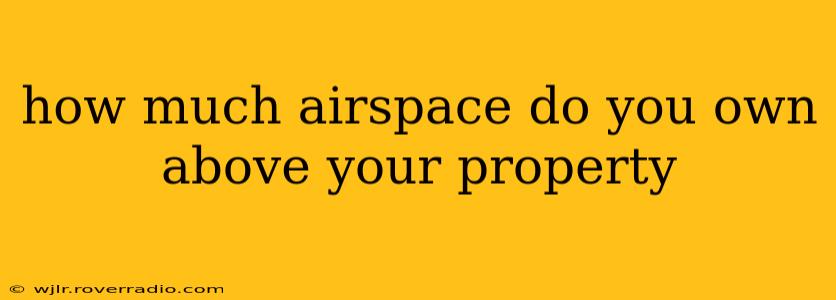How Much Airspace Do You Own Above Your Property? A Complex Question with No Simple Answer
The question of how much airspace you own above your property is surprisingly complex and doesn't have a single, universally applicable answer. It depends significantly on your location, specific laws, and the context of any potential disputes. While the common understanding is that property owners have some rights to the airspace above their land, the extent of those rights is far from absolute.
This article will explore the intricacies of airspace ownership, addressing common questions and clarifying the legal complexities involved.
What is the general rule regarding airspace ownership?
The general principle, established through centuries of common law, is that landowners own the airspace above their property to a reasonable height. This "reasonable height" is not fixed and is highly dependent on the situation. It's not infinite; you don't own to the edge of space! Traditionally, the height was considered to extend only as high as necessary for the ordinary use and enjoyment of the land. This might include building a house, planting trees, or using the airspace for other typical land-based activities.
Does this mean I own all the airspace above my house?
No. While you have rights to the airspace above your property, these rights are not unlimited. The concept of a "reasonable height" is crucial. Aircrafts, for example, regularly fly over private property, and this is generally accepted as legal provided they maintain a safe and reasonable altitude. This is balanced against the landowner's right to quiet enjoyment of their property. Extremely low-flying aircraft could be considered a nuisance and a violation of your property rights.
What about drones? Can I stop a drone from flying over my property?
Drone use is a relatively new area of airspace law and remains subject to ongoing interpretation and legal challenges. Generally, drones are permitted to fly over private property at a reasonable height, as long as they don't interfere with the use and enjoyment of the land. However, if a drone is used intrusively, such as for illegal surveillance or causing a disturbance, legal action might be possible. The legality of drone usage greatly depends on local regulations and specific circumstances.
At what height does airspace ownership generally end?
There's no universally defined height at which airspace ownership ends. The concept of a "reasonable height" remains fluid and context-dependent. Legal precedents, specific statutes, and the nature of the activity in question all play a significant role in determining the limits of airspace ownership.
Are there any exceptions to airspace ownership?
Yes, several exceptions exist. These include:
- Air navigation: The right of aircraft to fly over property at a reasonable altitude is generally accepted as a necessary exception to complete property ownership of airspace.
- Public utility easements: Power lines, communication towers, and other public utilities often have easements that allow them to utilize airspace above private property.
- Federal regulations: Federal laws governing aviation and air traffic control supersede local property rights when it comes to air navigation.
How can I protect my airspace rights?
Protecting your airspace rights involves understanding your local laws, documenting any infringements, and considering legal action if necessary. If you believe someone is violating your airspace rights, it's essential to gather evidence (photos, videos, witness statements) and consult with a lawyer specializing in property law.
This information is for general knowledge and does not constitute legal advice. Specific legal advice should always be sought from a qualified attorney in your jurisdiction. The laws regarding airspace ownership are complex and vary by location. Always consult with a legal professional for guidance on your specific situation.
